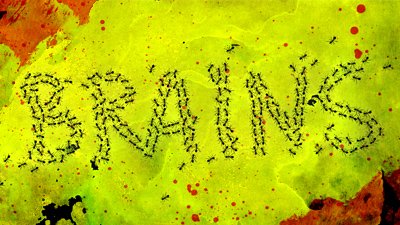Big Bugs and Birds
Big bugs met birds and bit the dust.
News Source
- ScienceDaily: “Reign of the Giant Insects Ended With the Evolution of Birds”
Super-sized flying insects are not just science fiction fodder: the fossil record documents insects with wingspans up to 70 cm (28 inches). (Not all insects got that big. There were plenty of small insects too, and some—like cockroaches, thankfully—never grew to mammoth proportions!) Why some insects grew so big and why they don’t anymore are both explored in a study by U.C.–Santa Cruz earth scientist Matthew Clapham published in the 4 June Proceedings of the National Academy of Sciences.
Theories vary as to why some insects grew so large. “Gigantism has been linked to hyperoxic conditions because oxygen concentration is a key physiological control on body size, particularly in groups like flying insects that have high metabolic oxygen demands,”1 writes Clapham. Atmospheric models suggest oxygen concentrations in the atmosphere once reached as high as 30 percent, compared to the present-day normal of 21 percent.
Clapham and graduate student Jered Karr report they compared wingspans of 10,500 fossilized insects to atmospheric oxygen levels over geologic time since the Cambrian explosion. “Maximum insect size does track oxygen surprisingly well as it goes up and down for about 200 million years,” Clapham said. “Then right around the end of the Jurassic and beginning of the Cretaceous period, about 150 million years ago, all of a sudden oxygen goes up but insect size goes down. And this coincides really strikingly with the evolution of birds.”
“The early birds were not very good at flying,” he says. “But by the end of the Cretaceous, birds did look quite a lot like modern birds.”
The atmospheric oxygen suggested by the “Geocarbsulf” computer model thus appeared to partially correlate with data from the fossil record. However, the flying reptile pterosaurs conventionally dated at 230 million years ago failed to demonstrate strong correlation with insect size. According to ScienceDaily, “There were larger insects in the Triassic than in the Jurassic, after pterosaurs appeared. But a 20-million-year gap in the insect fossil record makes it hard to tell when insect size changed.” There was also a more recent portion of the geologic column across which insect sizes could not be tracked. ScienceDaily reports, “Another transition in insect size occurred more recently at the end of the Cretaceous period, between 90 and 65 million years ago. Again, a shortage of fossils makes it hard to track the decrease in insect sizes during this period.” Clapham believes any of several factors could have been responsible for the scarcity of fossilized flying insects from this time, including the evolution of bats and “the continuing specialization of birds” as they became better predators, contributing to decimation and extinction of the giant insects. “The early birds were not very good at flying,” he says. “But by the end of the Cretaceous, birds did look quite a lot like modern birds.” Clapham suspects that the evolution of flying birds made maneuverability a survival advantage for insects and favored smaller insects.
The “Geocarbsulf” model for estimating atmospheric oxygen over long ages is based on the expected atmospheric impact of vegetative biomass and of oxidizable minerals exposed to oxygen. Evolutionists presume there was a time—the Great Oxidation Event—when newly evolved photosynthesizing organisms finally oxygenated earth’s atmosphere. Balanced against oxygen produced by the increasing biomass of photosynthesizers is the presumed amount of exposed oxidizable minerals. Mineral exposure would be affected by processes such as volcanic activity, tectonic shifting, and weathering. According to Peter Ward, author of Out of Thin Air: Dinosaurs, Birds, and Earth’s Ancient Atmosphere, “Unfortunately there is no direct way to measure past oxygen levels. … Indirect methods based on an understanding of the relative ability of various minerals to undergo chemical changes in the presence or absence of oxygen have been used to infer relative oxygen levels, as have indirect methods based on biological evidence.”2
The “Geocarbsulf” model depends on a geologic, biologic, and temporal history of the earth in which uniformitarian assumptions govern the rates at which changes occur. The timeline for this history depends on unverifiable assumptions by which the geologic column is dated. Such a model ignores the drastic changes the global Flood wrought in the geologic and biologic factors affecting atmospheric oxygen.
God created the world about 6,000 years ago, supplying it with an oxygen atmosphere early in Creation Week. Plants would have been producing oxygen on Day Three and animals—including birds—would have needed it to breathe by Day Five. The global Flood and its aftermath may well have altered our atmosphere in some way. The Flood destroyed much oxygen-producing plant material. It remodeled the earth’s surface thereby changing the minerals exposed to the air. The Flood and its aftermath also altered the depth and temperature of the oceans thus changing the habitat of oxygen-producing phytoplankton as well as the oxygen-dissolving capacity of the water. Not only were these processes in chaotic disarray during the Flood year, but in the post-Flood world the changing climate could have continued to affect the atmosphere for many years.
If the pre-Flood atmosphere differed from our own, higher oxygen levels could have been a factor facilitating large insect size. Milder pre-Flood seasonal variations could have also permitted insect varieties with gigantic potential to reach their full size. In the more extreme seasons of the post-Flood world, gigantic varieties of insects may have been weeded out of the gene pool as those reaching maturity quickly would have had a reproductive advantage. However, the fossil record of insects and birds reflects their burial, primarily during the Flood, and bears no relationship to their supposed evolutionary appearance in history or to their extinction over millions of years.
Further Reading
- The Collapse of the Canopy Model
- Giant Bugs: Why They Once Roamed the Earth
- The First Atmosphere—Geological Evidences and Their Implications
- The Primitive Atmosphere
- The Organosubstrate of Life
- Potential Evidence for The Great Oxidation Event
- Ancient Oxygen-Rich Rocks Confound Evolutionary Timescale
- Toxin Lovers
- Primordial Soup Remains Lifeless
- Oldest Hairy Microbes Found In “Snowball Earth”
- Radiometric Dating: Back to Basics
- Radiometric Dating: Problems with the Assumptions
- Radiometric Dating: Making Sense of the Patterns
For More Information: Get Answers
Remember, if you see a news story that might merit some attention, let us know about it! (Note: if the story originates from the Associated Press, FOX News, MSNBC, the New York Times, or another major national media outlet, we will most likely have already heard about it.) And thanks to all of our readers who have submitted great news tips to us. If you didn’t catch all the latest News to Know, why not take a look to see what you’ve missed?
(Please note that links will take you directly to the source. Answers in Genesis is not responsible for content on the websites to which we refer. For more information, please see our Privacy Policy.)
Footnotes
- M. E. Clapham and J. A. Karr, “Environmental and Biotic Controls on the Evolutionary History of Insect Body Size,” PNAS 109, no. 27 (July 3, 2012): 10927–10930, doi: 10.1073/pnas.1204026109.
- Ward, Peter. 2006. Out of Thin Air: Dinosaurs, Birds, and Earth’s Ancient Atmosphere, p. 37. Washington, D.C.: Joseph Henry Press.
Recommended Resources

Answers in Genesis is an apologetics ministry, dedicated to helping Christians defend their faith and proclaim the good news of Jesus Christ.
- Customer Service 800.778.3390
- © 2024 Answers in Genesis






